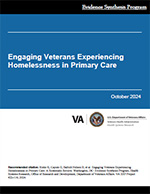
|
Recommended citation: |
Download PDF: Complete Report, Executive Summary, Report, Appendices
Findings from this review highlight the value of establishing and engaging Veterans experiencing housing insecurity in primary care and more specifically homeless-tailored primary care. Benefits may include reducing hospitalizations and emergency department visits. In addition, homeless-tailored primary care may provide some additional benefits over usual primary care for Veterans experiencing housing insecurity, including reduced inpatient hospitalizations and emergency department visits and increase appropriate use of emergency care, overall cost savings and better experiences with care. Future studies should aim to understand the specific features of homeless-tailored primary care and how they affect outcomes.
Veterans experiencing housing insecurity are a vulnerable population, and the US Department of Veteran Affairs (VA) has made addressing homelessness a priority. Physical illness, mental illness, and substance use diagnoses are all more common among Veterans experiencing housing insecurity than matched stably housed people. Given that Veterans experiencing housing insecurity have a high prevalence of a variety of physical and behavioral health diagnoses, it is important to understand the effect of establishing primary care on these individuals. This systematic review examines the impact of accessing primary care services on healthcare utilization and other outcomes in Veterans experiencing housing insecurity.
Four studies evaluated the effect of engaging Veterans experiencing housing insecurity in primary care, and 16 studies compared outcomes for Veterans experiencing housing insecurity in homeless-tailored primary care to standard or usual primary care. This report found that engaging Veterans experiencing housing insecurity in any primary care may significantly reduce hospitalizations and emergency department visits (moderate confidence). Among Veterans experiencing housing insecurity, primary care visits may be high after initial engagement in primary care and then decrease over time (low confidence). The studies either provided insufficient evidence (no conclusion) or did not evaluate housing/community integration outcomes, cost, specialty care utilization, disease specific outcomes, or Veteran experience. Homeless-tailored primary care compared to usual primary care may reduce inpatient hospitalizations and emergency department visits and increase appropriate use of emergency care (low confidence). Additionally, homeless-tailored primary care may reduce mental health and substance use visits (low confidence), and patient experiences may be better (low confidence). Homeless-tailored primary care may also increase primary care costs and reduce emergency department and overall health care costs (low confidence). There is no evidence for a difference in disease-specific outcomes for Veterans in homeless-tailored primary care compared to usual care (low confidence).
Engaging Veterans Experiencing Homelessness in Primary Care: A Systematic Review (Management Brief)